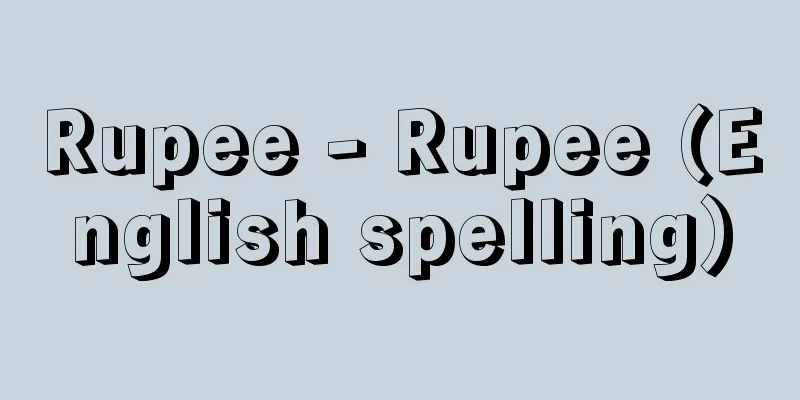Rupee - Rupee (English spelling)

|
The currency unit of India and the surrounding area. It is said to be derived from rûpya, which means gold and silver in Sanskrit. Since 1835, when the British colonial authorities determined that one rupee was a silver coin weighing 180 grains of pure silver, the rupee became the unified currency unit in British India. Under the silver standard, the rupee's exchange rate against the currencies of gold-standard countries often fluctuated greatly due to fluctuations in the gold-silver ratio. For this reason, in 1899, the gold exchange standard was adopted, and the rupee was linked to gold through the pound coin. Furthermore, from 1927, one rupee was fixed at 1 shilling and 6 pence. [Hara Makoto] Indian RupeeAfter the Second World War, India and Pakistan became independent in 1947, and both countries continued to use the rupee as their currency unit. They are also members of the International Monetary Fund (IMF), and the IMF parity is 1 US dollar = 4.7619 rupees. The Indian rupee was tied to the former colonial currency, the British pound, but this was abolished in September 1975, and the exchange rate system became fully floating in March 1993. The Indian rupee's exchange rate against the US dollar maintained the above-mentioned parity until 1965 under strict exchange control, but inflation of around 10% per year and a current account deficit continued, and in 1966 the rupee was devalued by more than 63%, and after remaining in the 7 Indian rupee range for more than 10 years, it began to fall at a fairly rapid pace in the 1980s, to 41 Indian rupees at the end of the 20th century.Although the decline (declining trend) slowed somewhat thereafter, it hit its lowest price to date of 48 Indian rupees in 2003. India has a population of 1.1 billion and its population grew at roughly 2% per year, but since the beginning of the 21st century, this has slowed to around 1.5%. Meanwhile, its economic growth rate has remained at around 5% since 1960 and further increased from the late 1980s into the 21st century, exceeding an average of 9% per year from 2005 to 2007. The estimated real gross domestic product (GDP) for 2008 is 80% higher than in 2000. This development since the 1980s can be attributed to the major shift towards economic liberalization that took place in 1991. The country ended its controlled economy and protectionist policies, relaxed or even abolished restrictions on foreign capital, and promoted industrialization. This led to a rapid increase in direct investment and securities investment from overseas, as well as increased borrowing from international organizations such as the International Bank for Reconstruction and Development (World Bank) and private banks, and India began to attract the attention of overseas investors. India has traditionally been an agricultural country, with the textile industry at the core of its manufacturing industry, but with the introduction of foreign capital, the automobile, motorcycle, home appliance, and IT (information technology) industries have developed, and today, the primary sector (agriculture, forestry, and mining) accounts for less than 20% of India's industrial structure, while the secondary sector (manufacturing) has overtaken it and now accounts for more than 20%. Furthermore, the tertiary sector is dominated by IT services, which supply software, and has expanded to reach 60%. India's trade is changing from a pattern of exporting textile products and iron ore and importing energy sources such as oil to exporting manufactured products and parts due to the aforementioned industrialization and lifting of import restrictions due to the expansion of the domestic market. The trade balance continues to be in deficit despite the change in pattern, but the export of services related to the IT industry and remittances related to services from residents working overseas have increased, and the current account balance is now roughly in balance or in surplus. The continued decline in the Indian rupee exchange rate mentioned above is likely contributing to an improvement in the balance of payments by adjusting the overvalued level. This improvement in the current account balance, plus the inflow of foreign funds mentioned above, has led to an improvement in India's overall external balance and an increase in India's official foreign exchange reserves, which stood at nearly US$300 billion in May 2008, the fourth largest in the world after Russia. However, there are factors that greatly affect the Indian economy. The first is the effect of rainfall on agriculture, which affects the amount of agricultural produce and the overall economy through changes in the income of agricultural workers. The second is the economic trend of the United States, which is the largest export market, and a recession in that country leads to a worsening of the trade balance. The third is the movement of oil and energy prices, and the Gulf War (1990) led to an expansion of the current account deficit. Furthermore, the fourth is the income from Indians working overseas, which is an important factor in the country's external balance. Although the trade and services balance was in deficit by $31.2 billion in 2006, remittances from overseas were $27.4 billion, which significantly mitigated the deficit. Incidentally, the internationalization of financial markets has progressed since the end of the 20th century, and while there are benefits to this, it has also become common to see situations that disrupt the foreign exchange and securities markets due to the rapid movement of short-term funds. The East Asian currency crisis, which began with the sudden fall of the Thai baht in August 1997, led to the withdrawal of foreign capital that had flowed into India, and the Indian rupee also fell by about 20% against the US dollar in one year. Furthermore, the financial crisis caused by the US subprime mortgage that surfaced in August 2007 spread to the world's financial markets, greatly affecting the stock market and foreign exchange market, and is dealing a serious blow to the real economy. In India, too, since the 1990s, there has been a growing movement to withdraw US dollar funds invested in the country and return them to the US dollar, and the Indian rupee fell by 26% from August 2007 to December 2008, reaching an all-time low of 50.275 Indian rupees per US dollar in early December. During that time, the central bank (Reserve Bank of India, RBI) is believed to have used its foreign exchange reserves of about 40 billion dollars to intervene in the market, and the Indian rupee remained at a level of 48 Indian rupees in early 2009. Furthermore, there was information that a major Indian bank was holding about $1 billion in bonds from a major American investment bank that had gone bankrupt, and there was a temporary run on the bank, but this subsided when the central bank announced that the bank's assets were in a sound state. However, the current crisis is accelerating a global recession, including in the United States, and India is at a critical juncture in its efforts to maintain the prosperity it has enjoyed since the turn of the new century. India's per capita GDP was $977 in 2007, more than ten times what it was in 1960. However, the country remains poor, and is not as rich as China or Indonesia. However, this is precisely why it is expected to develop as a potentially large market, and why it is being talked about as one of the "BRICs" (Emerging Markets with Large Populations). [Hara Makoto] Pakistani RupeeThe initial parity was maintained until 1971, but in 1972 it was devalued to less than half, to 10 Pakistani rupees per US dollar, and since 1982 it has depreciated year by year, falling below 53 Indian rupees in 2000. The country was plagued by a high inflation rate and a growth rate of just over 5%, as well as domestic and international political instability, poor harvests of cotton, the country's main export product, due to bad weather, rising prices of crude oil, the country's largest import product, and competition with China and India in its main export markets. The trade balance, which was already in deficit, has expanded, especially since 2004. Since the beginning of the 21st century, investment in the country has grown, with foreign capital flowing into sectors such as communications, IT, finance, and oil and gas extraction, enough to cover the trade deficit to a large extent. However, the aforementioned global financial crisis that began in the fall of 2007 caused the foreign capital that had been flowing in to flow out, and the Pakistani rupee reached its lowest exchange rate in history, at 78 Pakistani rupees per US dollar, as of January 2009. This crisis will have a major impact on the real economy, and Pakistan's exports will become even more unstable. International aid, including from Japan, is planned, but the political instability is serious, and the Pakistani rupee exchange rate is likely to remain unstable for the time being. [Hara Makoto] othersBesides India and Pakistan, Mauritius, Seychelles, Sri Lanka and Nepal also use the same currency unit. The minor currency units are the paisa in India and Pakistan, the cent in Mauritius, Seychelles and Sri Lanka, and the pice in Nepal, all of which are 1/100th of the rupee. The Indian rupee is used as is in Nepal, while Bhutan's own currency, the nutlam, is used at an equal rate to the Indian rupee. The average exchange rate of the Sri Lankan rupee against the US dollar in 2007 was 110.62 Sri Lankan rupees to the US dollar. [Hara Makoto] [References] | |Source: Shogakukan Encyclopedia Nipponica About Encyclopedia Nipponica Information | Legend |
|
インドおよびその近辺地域の通貨単位。サンスクリットで金銀を意味するrûpyaに由来するといわれる。1835年にイギリス植民地当局が180グレーンの純銀量目をもつ銀貨を1ルピーと定めて以来、ルピーがイギリス領インド地域の統一的な通貨単位となった。銀本位制下のルピーは、金銀比価の変動によって対金本位国通貨との相場がしばしば大きく変動した。このため1899年には金為替(かわせ)本位制を採用し、ポンド貨を通して金と結び付くこととなった。さらに1927年からは、1ルピーは1シリング6ペンスに固定された。 [原 信] インド・ルピー第二次世界大戦後の1947年、インドとパキスタンは分離独立、両国とも継続してルピーを通貨単位とした。また国際通貨基金(IMF)に加盟しており、IMF平価は1米ドル=4.7619ルピーであった。インド・ルピーは旧宗主国通貨英ポンドに結び付いていたが、1975年9月にこれを廃止し、1993年3月に完全な変動相場制となった。 インド・ルピーの対米ドル相場は、厳しい為替管理のもと前記の平価を1965年まで維持したが、年間10%前後のインフレーションや経常収支の赤字が続き、1966年に63%余りの切下げを行い7インド・ルピー台を10年余り続けた後、1980年代にかなり急ピッチで下落、20世紀末には41インド・ルピー、さらに、その後やや落潮(下落の傾向)は緩やかになったが、2003年48インド・ルピーと、それまでの最安値になった。 インドは11億の人口を抱え、おおむね年2%の率で増加してきたが、21世紀に入ってから1.5%前後に落ちてきた。一方、経済の成長率は1960年以降5%前後で推移し、1980年代末期から21世紀にかけてさらに高まり、とくに2005~2007年では年平均9%を超え、2008年の実質国内総生産(GDP)の推計値は2000年より80%も高い。 このような1980年代以降の発展は1991年に行われた経済自由化への大きな転換が貢献している。それまでの統制経済的、保護主義的政策をやめ外資導入規制を緩和ないし撤廃、工業化を促進した。かくして海外からの直接投資や証券投資が急増し、それに国際復興開発銀行(世界銀行)など国際機関や民間銀行からの借入れも増加して、インドは海外投資家の注目を浴びるようになった。 インドは伝統的に農業国であり、繊維工業が製造業の中心であったが、外資導入により自動車、二輪車、家電、そしてIT(情報技術)産業が発展し、いまやインドの産業構造は、第一次部門(農林、鉱業)の比率が20%を割り、第二次部門(製造業)がそれを抜いて20%を超える態勢にあり、さらに第三次部門はソフトを供給するITサービスが広がって60%に達するという状況である。 インドの貿易は、繊維製品や鉄鉱石の輸出、石油などエネルギー源の輸入というパターンから、前記のような工業化による製品や部品の輸出および国内市場拡大による輸入制限撤廃など内容が変化しつつある。貿易収支はパターンの変化にかかわらず継続して赤字だが、IT産業関係のサービス輸出と、サービスに関連して海外で働く居住者からの送金が増加し、経常収支はおおむね均衡または黒字を出すようになった。 先に示したインド・ルピー相場の継続的な下落は割高な水準の調整で収支の改善に貢献していると思われる。 このような経常収支の改善に加えて、前記のような外国資金の流入で、対外総合収支は好転、インドの公的外貨準備は増加し、2008年5月にはほぼ3000億米ドルと、ロシアに次ぐ世界第4位の額となった。 しかしインドの経済に大きく影響する要因がある。第一は農業に対する降雨量の影響で、農産物の生産量を左右し、農業労働者の所得の変化を通じて経済全体を動かす。第二は最大の輸出市場であるアメリカの景気の動向で、同国の不況は貿易収支の悪化となる。第三は石油あるいはエネルギー価格の動きで、湾岸戦争(1990)は経常赤字の拡大をもたらした。さらに第四として、海外で出稼ぎをしているインド人からの収入は当国の対外収支の重要な要素で、2006年の貿易サービス収支が312億ドルの赤字となっているのに、海外からの送金は274億ドルで、赤字をかなり和らげている。ところで、20世紀末から金融市場の国際化が進み、そのメリットもあるかわり、短期資金の激しい移動によって、外国為替市場や証券市場を混乱させる事態がよくみられるようになった。 1997年8月タイ・バーツの急落から始まった東アジアの通貨危機で、インドへ流入していた外国資金の引上げが起こり、インド・ルピーも1年間に約20%も米ドルに対して下落した。さらに2007年8月に表面化したアメリカのサブプライムローンを起因とする金融危機は、世界の金融市場に広がり、株式市場、為替市場に大きな影響を及ぼし実体経済にも、深刻な打撃を与えつつある。インドでも1990年代以降、同国に投資した米ドル資金を回収して米ドルに戻そうという動きが強まり、インド・ルピーは2007年の8月から、2008年の12月までに26%も下落し、12月初めには1米ドル当り50.275インド・ルピーと史上最安値を記録した。その間、中央銀行(インド準備銀行、RBI)は約400億ドルの外貨準備を使って、市場介入したとみられ、2009年初めでは48インド・ルピーの水準で推移した。なおインドの大手銀行が、破綻(はたん)したアメリカの大手投資銀行の債券を約10億ドル保有しているという情報で、一時同行への取付け騒ぎがあったが、中央銀行が同行の資産状態は健全であると公表して収まった。しかし今回の危機は、アメリカをはじめ、世界大の不況を進める過程をとっており、インドも新世紀への移行以来の好調をいかに維持するか重大な時期にある。 インドの1人当りのGDPは2007年では米ドル換算977ドルで、1960年の10倍強となった。しかしやはりまだ貧しいことは変わらず、中国やインドネシアにも及ばない。だがそれだけに潜在的な大市場として今後の発展が期待され、「巨大人口をもつ新興国」(BRICs(ブリックス))として話題となるゆえんである。 [原 信] パキスタン・ルピー当初の平価は1971年まで維持されたが、1972年には1米ドル=10パキスタン・ルピーと半分以下に切り下げられ、1982年以降年々減価し2000年には53インド・ルピーを下回った。高いインフレ率のもとで成長率もせいぜい5%を超える程度で、内外の政情不安、悪天候による主要輸出品綿花の不作、そして最大の輸入品たる原油価格の上昇、主要輸出市場では中国やインドとの競合など悪条件に悩まされ、もともと赤字構造であった貿易収支はとくに2004年以降拡大した。21世紀に入ってから、同国への投資が伸び、とくに通信、IT、金融、石油、ガス採掘などの部門に外資が入り、貿易収支の赤字をかなりまかなうほどであった。しかし2007年秋から始まった前掲の世界金融危機で、いままで入っていた外国資本が逆に流失し、パキスタン・ルピーは2009年1月時点で1米ドル=78パキスタン・ルピーと史上最低の相場を示した。この危機は実体経済に大きく影響し、パキスタンの輸出もさらに不安定になろう。日本も含めて国際的支援が計画されているが、政情不安も深刻で、パキスタン・ルピー相場も当分不安定となろう。 [原 信] その他インド、パキスタンのほか、モーリシャス、セイシェル、スリランカ、ネパールの諸国が同名の通貨単位を使用している。補助通貨単位は、インド、パキスタンはパイサpaisa、モーリシャス、セイシェル、スリランカはセントcent、ネパールはパイスpiceで、いずれもルピーの100分の1である。またネパールではインド・ルピーがそのまま流通し、ブータンでは固有の通貨ヌトラムとインド・ルピーが等価で流通している。なおまた、スリランカ・ルピーの対米ドル相場は2007年平均で1米ドル=110.62スリランカ・ルピーである。 [原 信] [参照項目] | |出典 小学館 日本大百科全書(ニッポニカ)日本大百科全書(ニッポニカ)について 情報 | 凡例 |
>>: Ruby - Ruby (English spelling)
Recommend
Atoll - Kansho (English spelling) atoll
A donut-shaped coral reef with no island in the ce...
Antonio I
... This slave trade encouraged armed conflict am...
Celer
…Although all of the ancient Greek architectural ...
sun synchronous orbit
...Also, the orbit of a satellite in a polar orbi...
Sandwort
...An annual to perennial weed of the Caryophylla...
Stalingrad
…It means “City on the Volga River” and was calle...
Kontenrahmen (English) German
It refers to a standard accounting system (system ...
Balanced Budget
In central and local government budgets, this ref...
Rosa ursina sive sol (English spelling) Rosaursinasivesol
… [Modern Observations with Telescopes] Telescopi...
Yoshihisa Kuzu
1874-1958 A nationalist from the Meiji to Showa e...
Farmers' representative - Hyakushodai
A village official in the Edo period. Along with t...
Onigiri (food) - Onigiri
...Rice balls made into a solid ball. Also called...
Yasugi [city] - Yasugi
A city in eastern Shimane Prefecture. It was incor...
Stain removal (stain removal) - Stain removal
This refers to home economics techniques for remov...
'Abbās Mahmūd al-'Aqqād
1889 - 1964 Egyptian philosopher, poet, and histo...





![Funahashi [village] - Funahashi](/upload/images/67ccb880cfcb6.webp)
![Suifu [village] - Suifu](/upload/images/67cbf17f3ca21.webp)


